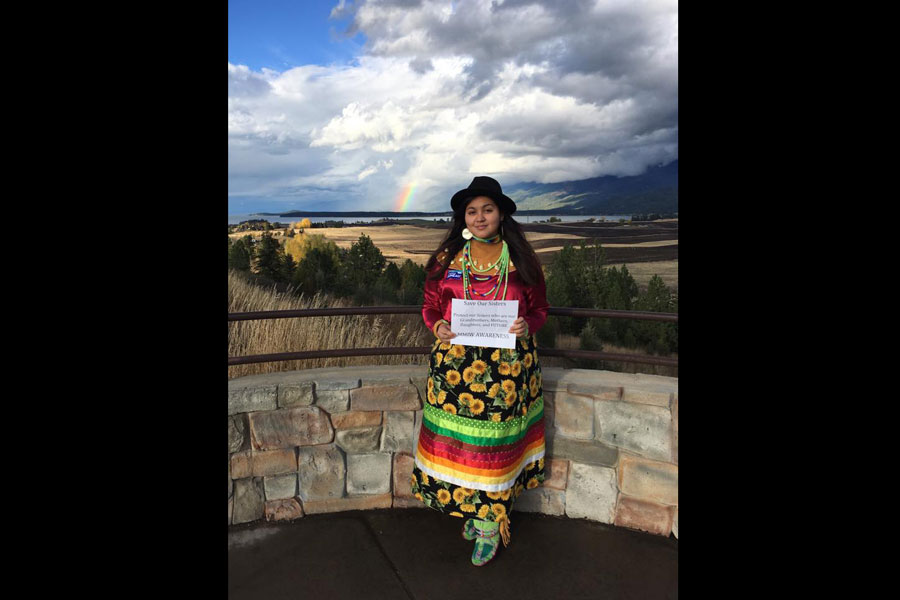As a senior at Polson High School, Marita Growing Thunder hand-sewed a colorful ribbon dress every single day of the term as part of a yearlong project dedicated to raising awareness for missing and murdered Indigenous women.
She dedicated each dress — about 180 in all — to an individual missing or murdered Indigenous woman (MMIW), a feat she said is dwarfed by the knowledge that tens of thousands of women remain unaccounted for and don’t have a dress.
Today, Growing Thunder is a freshman at the University of Montana, and she doesn’t have time to make a dress a day. So for the second year in a row she’s walking 80 miles across the Flathead Indian Reservation, from the northern edge near Rollins south to Arlee, to educate the public about the social injustices surrounding cases of MMIW.
In her own family, Growing Thunder said she lost two aunts to homicide — a great aunt on her father’s side who was killed while hitchhiking, and an aunt on her mother’s side that was killed by a husband — and can’t recall a time in her life where violence against Indigenous women hasn’t been a concern for her.
“This is our day-to-day life,” she said.
There are 3,000 open cases in Canada alone, a number that is thought to be much higher in the United States, where a database to track the instances doesn’t yet exist.
Growing Thunder belongs to the Fort Peck Assiniboine Sioux Tribe, but she grew up on the Flathead Indian Reservation, where violence against Indigenous women was a part of life. But so was speaking up about it, which is what motivates Growing Thunder to continue raising awareness for MMIW.
“I was very fortunate to grow up in a family with supportive, strong native women around me,” she said. “But it’s a problem that is intergenerational. It’s affecting my generation. It affected my mother’s generation, and her mother’s generation and generations before her.”
In Montana, where Native American women make up about 3 percent of the overall population, they made up about 6 percent of homicide victims between 2011 and 2015, according to the Montana Department of Public Health and Human Services’ 2015 vital statistics report. The Indian Law Resource Center states that one in three Native American women will be raped in their lifetime, and three in five will experience physical assault. In addition, they face a murder rate that is ten times higher than the national average.
Despite the disproportionate abuse and violence that Indigenous women experience, there is currently no national database of Indigenous Women missing in the U.S. The lack of government and popular attention paid to missing and murdered Indigenous women is what motivates Growing Thunder to continue organizing MMIW awareness walks.
“We are not disposable,” Growing Thunder said. “It’s important to honor and acknowledge the Indigenous Women who are missing or have been murdered. We walk for those who have been denied the right to walk.”
While some legislative efforts have been made to protect the lives of Indigenous women, they have been found inadequate.
A December 2017 report by the U.S. Office of the Inspector General stated that the 2010 Tribal Law and Order Act law, written with specific language to combat sexual and domestic violence against Native Women, was failing on numerous occasions. The U.S. Office of the Inspector General’s 90-page report states “the Department [of Justice] and its components still lack a coordinated approach to overseeing the assistance it provides in Indian Country. Further, the Department has not prioritized assistance to Indian country at the level consistent with its public statements or annual reports to Congress.”
Growing Thunder started her “Save Our Sisters: MMIW Awareness” walk with about 20 others on March 25 and plans to finish her journey on March 28, after the Beacon went to print.
She said while the walk takes a physical toll on her, it is also cathartic, in part because it invites conversation about the issue and raises awareness.
“There is a sense of rebirth and connection when a group of people open up and share stories about missing and murdered Indigenous women,” she said.
